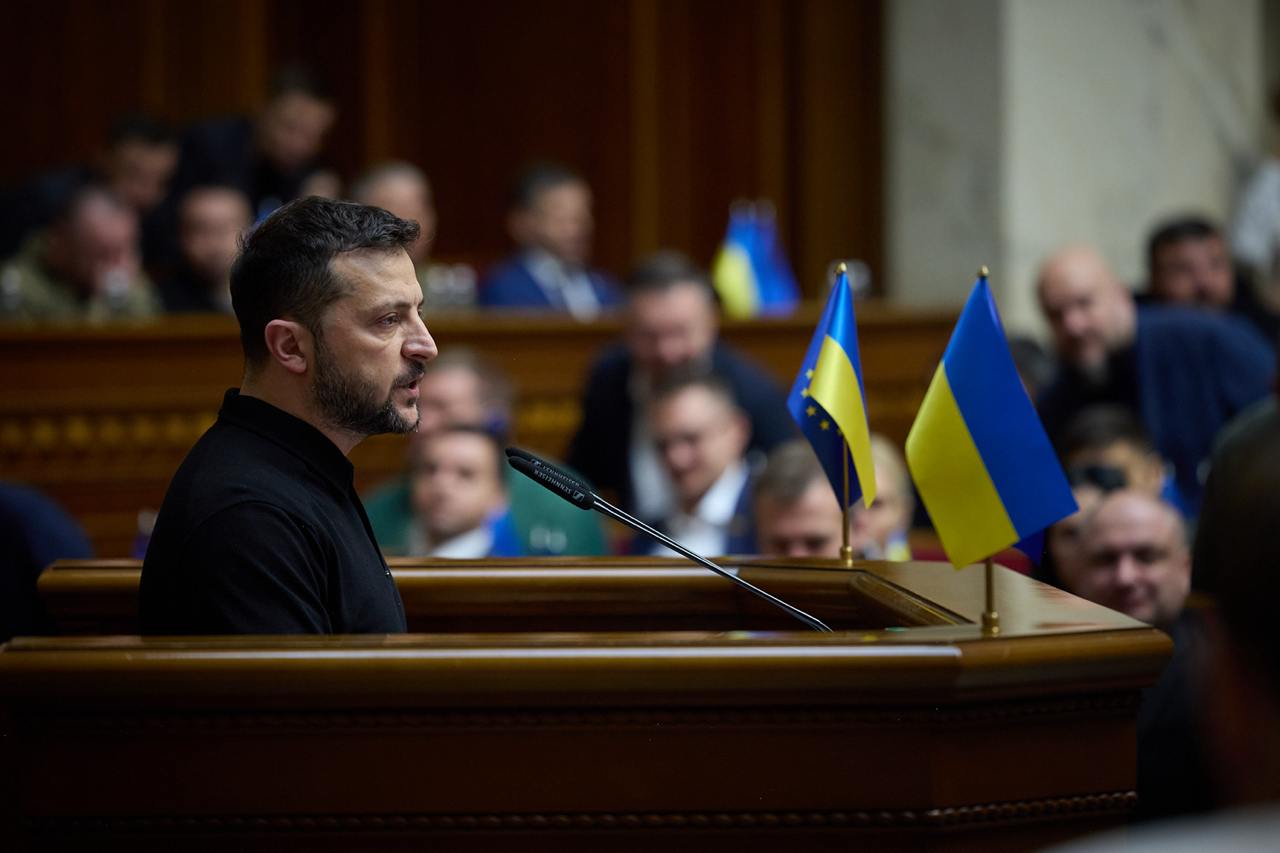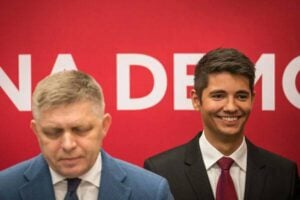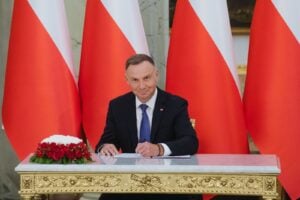Zelenskyy presents a victory plan in the Verkhovna Rada: five points and three secret annexes
16 October 2024 20:46 ANALYSIS FROM
ANALYSIS FROM on 16 October, President of Ukraine Volodymyr Zelenskyy addressed the Verkhovna Rada, presenting a victory plan containing five key points covering military, economic and political aspects. According to the President, this set of measures should help Ukraine win the war started by Russia on 24 February 2022. In addition, the plan includes three secret annexes that are being discussed with international partners.
Geopolitics: the path to NATO
The first point of the plan relates to geopolitics and provides for Ukraine’s invitation to join NATO. Zelenskyy stressed that this would send an important signal to Russian President Vladimir Putin, demonstrating the defeat of his geopolitical ambitions. Ukraine’s membership in the Alliance will ensure long-term peace and security in the region.
Defence: provision of weapons
The second point focuses on defence. The President outlined the list of weapons needed to support the Ukrainian military. In the context of the Kursk operation, Zelenskyy noted that pressure from the Armed Forces had already demonstrated the lack of resources of the Russian military.
Deterrence: a strategic response
The third point concerns deterring Russia. A secret annex to this point has been handed over to the US and other key allies. Ukraine proposes to create a non-nuclear deterrence package that can guarantee security against any threat from Russia. Zelenskyy stressed that, understanding the possible response, Russia would rather choose negotiations than further escalation.
Economy: strategic resources
The fourth point is devoted to the economy, including the use of Ukraine’s natural resources, such as uranium, titanium, lithium and others. These resources have the potential to significantly strengthen the position of Ukraine and its allies in the global market. This, according to Zelenskyy, will become an additional lever of economic pressure on Russia.
Security after the war
The last, fifth point is designed for the post-war period and involves the participation of the Ukrainian military in ensuring security in Europe. Zelenskyy suggested that Ukrainian soldiers could replace part of the US troops in Europe, strengthening NATO’s defence.
In an exclusive commentary for "Komersant Ukrainian", Volodymyr Fesenko specifically touched on the fifth point of the plan. The political analyst called it a strategic step that may appeal to both Trumpists and European partners who fear a reduction in the US military presence on the continent.
“Zelenskyy offers a real alternative: the Ukrainian military can take the place of American contingents, which will strengthen Europe’s defence. However, for this to happen, Ukraine must become a member of NATO or the EU, or enter into bilateral agreements,” Fesenko said.
The political analyst clarified that this is the idea of Ukraine’s friend and former British Prime Minister Boris Johnson.
Reaction of international partners
TheUnited States has so far rejected the first point of the Victory Plan. This is how the media interpreted the words of the US Permanent Representative to NATO, Ambassador Julianne Smith.
“We are not at the point where NATO is ready to invite Ukraine in the short term,” said Ambassador Julianne Smith, the US Permanent Representative to NATO.
At the same time, the U.S. Ambassador to NATO assured that all the assistance Ukraine needs to defend its territory will be provided.
However, Volodymyr Fesenko advises not to draw conclusions from one statement. The political analyst stressed that the key focus is on the reaction of international partners, especially the United States and Europe. However, according to Fesenko, this reaction will largely depend on the change of administration in the United States.
“We must understand that the final reaction of the US will become clear after the election of a new president. The current Biden administration is coming to the end of its term, and its political decisions may not have a long-term effect, as the new president may choose a completely different position,” Fesenko said.
However, it is up to the alliance to decide whether Ukraine should join NATO.
“This issue can only be resolved by the NATO summit. No president, neither of the US nor of European countries, has the authority to make such decisions alone,” Fesenko said
Thediscussion of Ukraine’s membership has already become a significant step forward, the political scientist adds.
Also, one should not expect a single coordinated response from either the US or Europe, as different points of Zelenskyy’s plan may elicit different responses.
“For example, we can expect positive decisions on the supply of certain types of weapons soon. At the same time, other decisions may be postponed until better times, as is the case, for example, with the provision of long-range weapons to Ukraine,” explained Volodymyr Fesenko
Fesenko stressed that part of the ideas in Zelenskyy’s plan is to push international partners to form a joint force strategy for Ukraine and Russia.
“The essence of this plan is not about a military victory, but about the fact that our partners should form a joint strategy of action to put pressure on Putin by force. However, not everyone is ready for such steps, and this is obvious,” he said.
At the same time, there are already first reactions from European partners. Before the EU summit, Slovak Prime Minister Robert Fico made an unexpected statement about the high probability of ending the war in Ukraine in the near future.
“The probability of ending the war in Ukraine in a short time is very high,” Fico said.
Adding that he expects the European Council meeting to indicate when this might happen, “as the topic of inviting Ukraine to NATO is suddenly raised”.
Kremlin’s reaction
The Russian dictator’s spokesman, Dmitry Peskov, reacted to the plan for Ukraine’s victory presented by President Vladimir Zelensky without having seen it, but has already said that it is “the plan of the Americans” to fight Russia “to the last Ukrainian”.
“For several weeks now, some mythical peace plan has been discussed. Most likely, this is exactly the plan of the Americans to fight us to the last Ukrainian, which Zelensky has now disguised,” Peskov said, repeating the Kremlin’s propaganda theses about the US role in the war.
This statement once again demonstrates the rhetoric of the Russian authorities, who are constantly trying to shift the responsibility for the war to the West, ignoring the facts of Russia’s aggression against Ukraine.
Reaction of the Armed Forces of Ukraine
Kyrylo Sazonov, who is currently serving on the front line, expressed his thoughts on the victory plan presented by President Volodymyr Zelenskyy in the Verkhovna Rada. Sazonov noted that the key point is that the success of the plan depends solely on Ukraine and its allies, not on Russia.
“Russia does not want a just peace,” he quoted the president as saying. In his opinion, those who still have illusions about the Kremlin’s peacefulness should say goodbye to them.
Sazonov also draws attention to the first point of the plan – inviting Ukraine to join NATO, which, according to Zelenskyy, is a critical step in defining Ukraine’s role in the security system.
“We are now not a supplicant for NATO, but a valuable partner. Ukraine has the strongest army in Europe with real combat experience and numerous veterans,” says Kyrylo Sazonov
However, Sazonov supports Zelensky’s optimistic forecast that if the plan is implemented now, the war can be ended by 2025.
“We will work. Everyone is in their place. Of course, everyone is tired, but the chase ends not when you are tired, but when your pursuer is tired or dead. In our case, it sounds even better,” summed up Kirill Sazonov.
Victory through strength and diplomacy
Zelenskyy concluded that in order to force Russia to negotiate on terms favourable to Ukraine, it is necessary to combine military and political measures. This plan will be the basis for a victory that will ensure peace and stability for Ukraine and the entire democratic world.
Author – Anastasia Fedor









